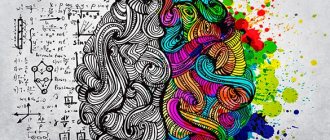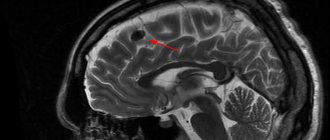SPEECH HEARING AND PHONEMATIC HEARING
Hearing is a person’s ability to perceive sounds and navigate the environment.
It is customary to distinguish:
- Non-speech (physical) hearing. Allows you to perceive natural and everyday noises: steps, driving a car, rustling leaves, murmur of water, etc. It also includes hearing for music.
- Speech (phonemic) hearing. Responsible for understanding and reproducing human speech. With its help, the child masters the “code” of the language.
Speech hearing is a complex ability that is formed during life. Sound speech consists of phonemes (sounds), intonations, pauses, and stress. It allows you to catch them and distinguish them. For example, with its help a person distinguishes a castle from a castle, a bear from a bowl, a goat from a braid, etc.
WHICH HEMISPHERE IS RESPONSIBLE FOR SPEECH HEARING?
A person perceives sounds with the help of the organ of Corti - a labyrinth in which sound cells float in the lymph. From here begins the complex path of sounds from the ear to the temporal part of the cerebral cortex - 41 fields. This zone is also called the auditory zone.
Depending on the frequency of sound vibrations, different cells are excited in individual parts of the organ of Corti. They act on nerve endings, and the vibrations are converted into nerve impulses that enter the cerebral cortex. Sounds of different pitches are directed to different areas of the cortex.
All information from the left and right ears first reaches both hemispheres of the brain. However, sounds are processed separately in special areas of the cortex. The left hemisphere of the brain is responsible for recognizing phonemes. But the right hemisphere also participates in speech hearing - it analyzes different voices and intonations.
Guilt and Shame: Temporal Lobes
It is easy for us to understand how memory or counting can be processes occurring in the brain. However, feelings aren't quite so simple, partly because in speech we use phrases like "break your heart" to describe sadness or "blush" to describe shame. And yet, feelings are a phenomenon from the field of neurophysiology: a process that takes place in the tissues of the main organ of our nervous system. Today we can partially appreciate it thanks to neuroimaging technology.
As part of their research, Petra Michl and several of her colleagues at the Ludwig Maximilian University in Munich recently took a series of MRI scans. They sought to find areas of the brain that are responsible for our ability to feel guilty or ashamed. Scientists have found that shame and guilt seem to be neighbors on the block, although each of these feelings has its own anatomical region.
The researchers asked participants to imagine feeling guilty or ashamed, and in both cases it activated the temporal lobes of the brain. At the same time, shame involved the anterior cingulate cortex, which monitors the external environment and informs a person about mistakes, and the parahippocampal gyrus, which is responsible for remembering scenes from the past. Vina, in turn, “turned on” the lateral occipitotemporal gyrus and the middle temporal gyrus, the center of the vestibular analyzer. In addition, the anterior and middle frontal gyri began to work in shamed people, and in those who felt guilty, the amygdala (tonsils) and insula became more active. The last two areas of the brain are part of the limbic system, which regulates our basic fight-or-flight emotions, the functioning of internal organs, blood pressure and other parameters.
Having compared MRI images of the brains of people of different sexes, scientists found that in women, guilt affected only the temporal lobes, while in men, the frontal lobes, occipital lobes and tonsils began to work in parallel - one of the most ancient elements of the brain, which are responsible for feelings of fear, anger, panic and pleasure.
DEVELOPMENT FEATURES
Speech perception begins to form from the first months of a child’s life. At 1 month, the baby can already pick up speech. At 3-4 months he tries to repeat it, which is manifested by humming. Every month he gets better at it.
The development of the ability to understand speech is greatly influenced by auditory attention and auditory memory. Long-term memory contains a storage device called the “phoneme lattice.” In it, for each phoneme a certain standard is assigned (allowing deviations within certain limits). In other words, during the formation of speech hearing, significant signs of sounds are stored in memory. The child accumulates a certain “baggage” of phonemes.
As concentration increases and other mental functions develop, speech perception also improves. The main development of speech hearing occurs in the first 2–3 years of a person’s life. And although the child is not yet able to reproduce everything correctly, in the absence of violations he fully understands his native language.
The right hemisphere of the brain and its functions
The specialization of the right hemisphere of the brain is intuition and perception of non-verbal information, that is, data expressed in facial expressions, gestures and intonation of the interlocutor.
It is noteworthy that people with a developed right hemisphere are able to demonstrate their abilities in certain types of art: painting, modeling, music, poetry. This is explained by the fact that they are able to think spatially, without focusing on unimportant events in life. Their imagination is rich, which is manifested when writing paintings and musical works. They also say about such people: “Having their head in the clouds.”
People with a developed right hemisphere also have a number of characteristic features:
- They are overly emotional, and their speech is rich in epithets and comparisons. Often such a speaker swallows sounds, trying to bring as much meaning as possible into the spoken words.
- People with a developed right hemisphere are holistic, open, trusting and naive in communicating with others, but at the same time they are easily offended or offended. At the same time, they are not shy about their feelings - they can cry or become angry in a matter of minutes.
- They act according to their mood.
- Right-brain people are able to find non-standard ways to solve problems; this is explained by the fact that they consider the whole situation as a whole, without focusing on one thing.
FORMATION OF SPEECH HEARING AND PRONUNCIATION SIDE OF SPEECH
The development of speech perception is closely related to the formation of speech. Sensations associated with the work of the organs of articulation improve the understanding of phonemes. As perception develops, the child begins to analyze the correctness of pronunciation, identify and correct errors.
Games have a positive effect on the development of hearing and speech. For example:
- "Broken phone". Children sit in a row. The first player comes up with a word and whispers it in his neighbor's ear. He passes on what he heard further. The last one in the chain says the word out loud. The goal of the game is to correctly hear and convey what is said.
- "Magic Mirror". The guys choose a leader. He approaches one of the players to choose from and says: “Come on, mirror, look, repeat everything to us correctly!” I will stand in front of you, and you repeat after me.” Then he makes a movement and says a short phrase. The player must repeat everything exactly. If he makes a mistake, he drops out of the game, if not, he becomes the leader.
The development of the pronunciation side of speech ends by 4–5 years. At 5 years old, the organs of articulation are sufficiently formed to clearly reproduce all sounds, with the exception of [р], [р']. Normally, a five-year-old child is also able to regulate the volume of speech, pronounce words correctly, construct sentences, and use different intonations.
Tenderness and comfort: somatosensory cortex
In many cultures, it is customary to hide sadness and shock: for example, in British English there is even an idiomatic expression “keep a stiff upper lip,” which means “not to show your feelings.” However, neuroscientists argue that from the point of view of brain physiology, a person simply needs the participation of other people. “Clinical experiments show that loneliness provokes stress more than any other factor,” says German scientist, author of the book “The Science of Happiness” Stefan Klein. “Loneliness is a burden on the brain and body. The result is anxiety, confusion in thoughts and feelings (a consequence of stress hormones) and a weakened immune system. Isolation makes people sad and sick.”
Study after study shows that companionship is good for you physically and mentally. It prolongs life and improves its quality. “One touch from someone close to you and deserving of your trust eases sadness,” says Stefan. "This is a consequence of the neurotransmitters - oxytocin and opioids - that are released during moments of tenderness."
Recently, British researchers were able to confirm the theory of the usefulness of affection using computed tomography. They found that the touch of other people causes strong bursts of activity in the somatosensory cortex, which is already working constantly, tracking all our tactile sensations. Scientists have come to the conclusion that the impulses that arise if someone gently touches our body in difficult moments are associated with the process of isolating from the general flow of critical stimuli that can change everything for us. Experts also noticed that the experiment participants experienced grief more easily when a stranger held their hand, and much easier when their palm was touched by a loved one.
SPEECH HEARING AND SPEECH CULTURE
Speech culture is the ability to correctly use all language means: sounds, intonation, vocabulary, grammatical forms. A high culture of speech is characteristic of speakers, actors, poets, and journalists. Children master it in the process of communication, listening to fairy tales and poems. Speech hearing ensures correct pronunciation, capturing intonations, pauses, etc.
To improve speech culture, it is necessary to develop:
- correct speech breathing,
- control over voice strength, speech speed, intonation.
DEVELOPMENT OF SPEECH HEARING AND BREATHING
Correct speech breathing is an integral component of expressive speech. To speak fluently in phrases, you need to be able to take a short breath and exhale smoothly and long. Children who cannot control their breathing “choke” mid-sentence, lose the sonority of their voice, and mumble their words. Pronunciation suffers, and along with it, speech hearing does not develop.
To develop phonemic hearing, classes are held, including on the development of speech breathing. Example exercise:
"Bubbles." Children repeat a poem after an adult and at the same time wave their brushes towards themselves: “Hey, little mouse, look, we’re blowing bubbles.” In the next part of the poem, before naming the color, you need to puff out your cheeks and quickly exhale: “Blue, red, light blue - choose any one!”
Normally, a child 2–3 years old can utter 2–3 words while exhaling, 3–4 years old – 3–5 words, 4–6 years old – 5–6 words.
What will the development of each hemisphere give?
First, let's summarize: any human activity begins with a comparison of new data with previous experience, that is, the left hemisphere is involved in this process. At the same time, the right side of the brain influences the final decision - it is physically impossible to come up with something new based only on previous experience.
Such a holistic perception of reality allows one not to get hung up only on generally accepted norms and, accordingly, moves a person’s personal growth forward.
The development of the right hemisphere will help a person to more easily come into contact with others, and the left hemisphere will contribute to the correct expression of thoughts. This approach has a beneficial effect on achieving success not only in professional activities, but also in other activities related to communication within society. Therefore, thanks to the coordinated activity of both hemispheres, a person’s life becomes more harmonious.
To develop these abilities, experts recommend doing simple exercises that activate brain activity several times a day:
- If a person is not good with logic, then he is recommended to engage in mental work as much as possible - solve crosswords or frying pans, and also give preference to solving mathematical problems. If you need to develop creative abilities, then you can try to understand the meaning in fiction or painting.
- You can activate the work of one of the hemispheres by increasing the load on the side of the body for which it is responsible: for example, to stimulate the left hemisphere, you need to work with the right side of the body, and vice versa. In this case, the exercises do not have to be too complicated - just hop on one leg or try to rotate an object with your hand.
Examples of simple physical exercises to develop brain activity
"Ear-nose"
With your right hand you need to touch the tip of your nose, and with your left hand you need to touch the opposite right ear. Then we release them at the same time, clap our hands and repeat the action, mirroring the position of our hands: with our left hand we hold the tip of our nose, and with our right hand we hold the left ear.
"Ring"
This exercise is familiar to almost everyone since childhood: you need to quickly alternately connect your thumb with your index, middle, ring and little fingers into a ring. If everything works out without a hitch, then you can try doing the exercise with 2 hands at the same time.
"Mirror drawing"
Sit down, put a large sheet of white paper on the table, and a pencil in each hand. Then you need to try to simultaneously draw any geometric shapes - a circle, square or triangle. Over time, if everything works out, then you can complicate the task - try to draw more complex images.
It is noteworthy that an integrated approach to improving the activity of the cerebral cortex will help not only improve a person’s communication abilities, but will also slow down age-related changes in the psyche - as is known, an active lifestyle and mental work allow a person to remain young at heart and preserve his intellectual abilities.
SPEECH HEARING DISORDER
In early childhood, a child hears words unclearly and with distortion. Until the age of 2–3 years, he still does not fully understand spoken speech. Therefore, we can talk about speech hearing impairment only after reaching 3 years of age. It is installed by a specialist – a speech therapist. At such an early age, deviation is mainly indicated by the incorrect interpretation of individual words. For example, an adult asks to show a midge in the picture, and a child shows a cat.
Obvious signs of speech hearing impairment are detected after the final formation of the articulatory apparatus. At 5 years old, a child is already physiologically capable of reproducing phonemes. If he makes gross mistakes, this may be a sign of impaired phonemic hearing. Examples of such errors:
- replacing and mixing sounds;
- rearrangement of letters, syllables;
- omission or insertion of extra letters;
- incorrect stress in words.
The cause of impaired speech perception can be both pedagogical neglect and various pathologies: hearing loss, ADHD (attention deficit hyperactivity disorder), head injuries and diseases associated with inflammation of the brain.
FEATURES OF SPEECH DEVELOPMENT OF CHILDREN WITH HEARING IMPAIRMENT
Overcoming phonemic perception disorders is one of the main areas of speech therapy work. A properly designed set of classes helps to completely solve the problem in 3–12 months. If indicated, correction is carried out against the background of drug treatment or after it.
Speech therapy work includes 3 stages:
- Development of the ability to distinguish sound from the background of a word.
- Developing the skill of isolating sounds at the beginning, end and middle of a word.
- Formation of complex phonemic analysis: number, sequence of sounds, location, etc.
All exercises are veiled - they are carried out in the form of interesting games. The complex is developed for each child individually, depending on the severity and nature of the disorders. The main work is carried out by a specialist. At home, it is also useful to play games with your child that develop physiological breathing, phonemic hearing, analysis, auditory attention and memory.
If you don't intervene in time, the problem will get worse. The developmental features of children with speech hearing impairment are clearly evident at school. Already from the first year of study, they find themselves in the category of lagging students . Impaired speech perception entails gross errors in writing: “breathing” instead of “sentence”, “leste” instead of “leaves”.
Speech hearing is an ability that develops independently in the absence of diseases and in a favorable social environment. Receiving speech sounds, the brain remembers them and creates certain “standards”. Later he focuses on them, correcting the correct pronunciation. That is why it is so important in the first years of life to talk with the child often, without resorting to baby talk, to read a lot, to learn poetry and tongue twisters. But even if time is lost or perception is impaired as a result of illness, one should not despair. Speech hearing, like musical hearing, can be developed throughout life. The main thing is not to let the problem take its course!
Fear and Anger: The Amygdala
During intrauterine development of the embryo, the limbic system is formed immediately after the trunk, which organizes reflexes and connects the brain with the spinal cord. Her job is feelings and actions that are necessary for the survival of the species. The tonsils are an important element of the limbic system. These areas are located near the hypothalamus, inside the temporal lobes, and are activated when we see food, sexual partners, rivals, crying children, and so on. The body's various reactions to fear are also their work: if you feel like a stranger is following you at night in the park and your heart starts pounding, this is due to the activity of the tonsils. In the course of several independent studies conducted at various centers and universities, experts were able to find out that even artificial stimulation of these areas causes a person to feel that imminent danger is approaching.
Anger is also largely a function of the amygdala. However, it is very different from fear, sadness and other negative emotions. The amazing thing about human anger is that it is similar to happiness: like joy and pleasure, it makes us move forward, while fear or grief forces us to withdraw. Like other emotions, anger, malice and rage cover a variety of parts of the brain: after all, in order to realize their impulse, this organ needs to assess the situation, access memory and experience, regulate the production of hormones in the body and do much more.








